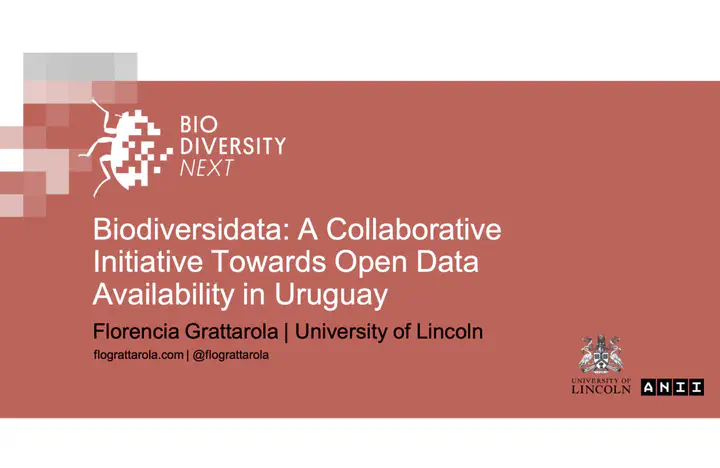Biodiversidata, A Collaborative Initiative Towards Open Data Availability in Uruguay

Data-sharing has become a key component in the modern scientific era of large-scale research, with numerous advantages for both data collectors and users. However, data- sharing in Uruguay remains neglected given that major public sources of biodiversity information (government and academia) are not open-access. As a consequence, the patterns and drivers of biodiversity in this country remain poorly understood and so does our ability to manage and conserve its biodiversity. To overcome this critical gap, collaborative strategies are needed to communicate the importance and benefits of data openness, exchange and provide technical tools and training on all aspects of data management, sharing practices, focus on incentives, and motivation structures for data- holders. Here, we introduce the Biodiversidata initiative (www.biodiversidata.org) – a novel Uruguayan Consortium of Biodiversity Data. Biodiversidata is a collaboration among experts with the aim of improving the country’s biodiversity knowledge and the open- access of the vast resources they generate. Biodiversidata aims to collate the first comprehensive open-access database on Uruguay’s whole biodiversity, to support advancements in scientific research and conservation actions. Currently, Biodiversidata consists of over 30 experts from across national and international institutions, studying diverse biodiversity groups. After less than two years, we have collected, curated and standardised a dataset of ~70,000 records of primary biodiversity data of tetrapod species – the first and most comprehensive open biodiversity database ever gathered for Uruguay to date. However, the process is hampered by multiple challenges:
- the lack of support for sampling of specimens and maintenance of collections has contributed to the situation were data are often perceived as personal property rather than collective resources;
- institutions have no plans or strategies directed to digitisation of their collections which actually places biodiversity data in Uruguay ‘at risk’ of being lost;
- the scarce governmental and academic incentive structures towards open scientific research relegates data-sharing to a personal decision;
- although scientists individually are willing to share their research data, the lack of data management plans within their research groups hampers the capacity to digitise the data and thus, to make them available;
- former initiatives aimed to create comprehensive biodiversity databases did not consider the balance between openness and gain for researchers, setting the subject of data-sharing more of an obligation than a path of promotion, which impacted negatively in the perception of scientist to open their data.
To overcome some of these challenges, we decided to direct Biodiversidata to individual researchers/experts and not institutions. We called them with the plan of collecting the maximum possible amount of data from vertebrate, invertebrate and plant species, use it to collaboratively generate impactful scientific research. An important aspect was that we requested data only to fit the premise of being primary biodiversity data (i.e., data records that document the occurrence of a species in space and time). This meant cleaning and standardising very heterogeneous information, from a variety of source types and formats, including updating scientific names and georeferentiating sampling locations. However, centralising the cleaning process allowed researchers to send their raw records without spending time cleaning them themselves and, as a consequence, enlarged the amount of data being collated. Collectively, Biodiversidata’s approach towards changing the culture of data-sharing practices has relied on the reinforcement of a scientific collaboration culture that benefits not only researchers at the individual level, but the progress of larger-scale issues as a whole. There is a long way to go on the subject of open research data in Uruguay, though, aiming strategies to people, capitalising data management and progressing with step-by-step rewards, is already showing some preliminary encouraging results.
Session: Perspectives from the Global South
Large parts of the tropical world in Africa, South America, and Asia are rich in biodiversity but there is a paucity of data. These areas also have large and dense human populations where development aspirations are altering ecosystems at an alarming pace. Documenting biodiversity and making the data available to scientific, policy and citizen communities will be instrumental in enhancing the prospects for biodiversity conservation in these areas. Global initiatives in biodiversity informatics and open data need to recognise the challenges faced by the global south. The broad challenges are 1. Community engagement and participation; 2. Capacities in biodiversity science and data; 3. Technology and infrastructure; and 4. Institutional and sustainability.
The symposium will focus on the current practices and challenges of biodiversity informatics in the global south. A strategy to weave together different initiatives at different scales and focus holds promise for building vibrant communities of practice in biodiversity informatics and an international network. The symposium will provide a forum for the exchange of experiences and ideas across a wide range of initiatives with diverse objectives from Asia, Africa, and South America. These would range from locale-specific to national and regional scales. They could be taxa-specific or attempt to cover the whole spectrum of biodiversity. The symposium aims to identify shared lessons and specific aspects of challenges faced by these initiatives. It will aim to initiate the development of a strategy for cooperatively addressing these challenges effectively. It will explore mechanisms to enable their stronger participation and enhanced contributions to global knowledge.